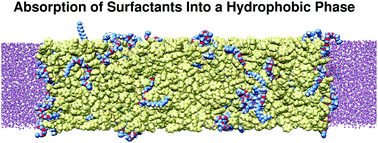当前位置:
X-MOL 学术
›
Phys. Chem. Chem. Phys.
›
论文详情
Our official English website, www.x-mol.net, welcomes your
feedback! (Note: you will need to create a separate account there.)
Shedding light on the different behavior of ionic and nonionic surfactants in emulsion polymerization: from atomistic simulations to experimental observations
Physical Chemistry Chemical Physics ( IF 2.9 ) Pub Date : 2017-11-07 00:00:00 , DOI: 10.1039/c7cp05206e Giulia Magi Meconi 1, 2, 3, 4, 5 , Nicholas Ballard 1, 2, 3, 4, 5 , José M. Asua 1, 2, 3, 4, 5 , Ronen Zangi 3, 4, 5, 6, 7
Physical Chemistry Chemical Physics ( IF 2.9 ) Pub Date : 2017-11-07 00:00:00 , DOI: 10.1039/c7cp05206e Giulia Magi Meconi 1, 2, 3, 4, 5 , Nicholas Ballard 1, 2, 3, 4, 5 , José M. Asua 1, 2, 3, 4, 5 , Ronen Zangi 3, 4, 5, 6, 7
Affiliation

|
Although surfactants are known to play a vital role in polymerization reactions carried out in dispersed media, many aspects of their use are poorly understood, perhaps none more so than the vastly different action of ionic and nonionic surfactants in emulsion polymerization. In this work, we combine experimental measurements of emulsion polymerization of styrene with atomistic molecular dynamics simulations to better understand the behavior of surfactants at monomer/polymer–water interfaces. In a batch emulsion polymerization of styrene, the nonionic surfactant Disponil AFX 1080 leads to two nucleation periods, in contrast to the behavior observed for the ionic surfactant SDS. This can be explained by the absorption of the nonionic surfactant into the organic phase at the early stages of the polymerization reaction which is then released as the reaction progresses. Indeed, we find that the partition coefficient of the surfactant between the organic phase and water increases with the amount of monomer in the former, and preferential partitioning is detected to organic phases containing at least 55% styrene. Results from molecular dynamics simulations confirm that spontaneous dissolution of the non-ionic surfactant into a styrene-rich organic phase occurs above a critical concentration of the surfactant adsorbed at the interface. Above this critical concentration, a linear correlation between the amount of surfactant adsorbed at the interface and that absorbed inside the organic phase is observed. To facilitate this absorption into a completely hydrophobic medium, water molecules accompany the intruding surfactants. Similar simulations but with the ionic surfactant instead did not result in any absorption of the surfactant into a neat styrene phase, likely because of its strongly hydrophilic head group. The unusual partitioning behavior of nonionic surfactants explains a number of observable features of emulsion polymerization reactions which use nonionic surfactants and should help with future development of processes for improved control over polymerization.
中文翻译:

揭示乳液聚合中离子和非离子表面活性剂的不同行为:从原子模拟到实验观察
尽管已知表面活性剂在分散介质中进行的聚合反应中起着至关重要的作用,但人们对其使用的许多方面了解甚少,也许仅是离子型和非离子型表面活性剂在乳液聚合中的作用截然不同。在这项工作中,我们将苯乙烯乳液聚合的实验测量结果与原子分子动力学模拟相结合,以更好地了解表面活性剂在单体/聚合物-水界面的行为。在苯乙烯的间歇乳液聚合中,与离子型表面活性剂SDS观察到的行为相反,非离子型表面活性剂Disponil AFX 1080导致两个成核期。这可以通过在聚合反应的早期将非离子型表面活性剂吸收到有机相中来解释,然后随着反应的进行将其释放。实际上,我们发现表面活性剂在有机相和水之间的分配系数随前者中单体的增加而增加,并且检测到优先分配给含有至少55%苯乙烯的有机相。分子动力学模拟的结果证实,非离子型表面活性剂自发溶解在富含苯乙烯的有机相中会在临界浓度的界面活性剂之上发生。高于该临界浓度,观察到在界面处吸附的表面活性剂的量与在有机相内部吸附的表面活性剂的量之间存在线性关系。为了促进这种吸收到完全疏水的介质中,水分子伴随着侵入的表面活性剂。类似的模拟,但是使用离子型表面活性剂代替,不会导致表面活性剂吸收到纯净的苯乙烯相中,这可能是因为其具有强亲水性的头基。非离子表面活性剂的不寻常的分配行为解释了使用非离子表面活性剂的乳液聚合反应的许多可观察到的特征,并且应该有助于改进聚合控制的方法的未来发展。可能是因为其亲水性强的头基。非离子表面活性剂的异常分配行为解释了使用非离子表面活性剂的乳液聚合反应的许多可观察到的特征,并应有助于改进聚合反应控制方法的未来发展。可能是因为其亲水性很强的头基。非离子表面活性剂的异常分配行为解释了使用非离子表面活性剂的乳液聚合反应的许多可观察到的特征,并应有助于改进聚合反应控制方法的未来发展。
更新日期:2017-11-22
中文翻译:

揭示乳液聚合中离子和非离子表面活性剂的不同行为:从原子模拟到实验观察
尽管已知表面活性剂在分散介质中进行的聚合反应中起着至关重要的作用,但人们对其使用的许多方面了解甚少,也许仅是离子型和非离子型表面活性剂在乳液聚合中的作用截然不同。在这项工作中,我们将苯乙烯乳液聚合的实验测量结果与原子分子动力学模拟相结合,以更好地了解表面活性剂在单体/聚合物-水界面的行为。在苯乙烯的间歇乳液聚合中,与离子型表面活性剂SDS观察到的行为相反,非离子型表面活性剂Disponil AFX 1080导致两个成核期。这可以通过在聚合反应的早期将非离子型表面活性剂吸收到有机相中来解释,然后随着反应的进行将其释放。实际上,我们发现表面活性剂在有机相和水之间的分配系数随前者中单体的增加而增加,并且检测到优先分配给含有至少55%苯乙烯的有机相。分子动力学模拟的结果证实,非离子型表面活性剂自发溶解在富含苯乙烯的有机相中会在临界浓度的界面活性剂之上发生。高于该临界浓度,观察到在界面处吸附的表面活性剂的量与在有机相内部吸附的表面活性剂的量之间存在线性关系。为了促进这种吸收到完全疏水的介质中,水分子伴随着侵入的表面活性剂。类似的模拟,但是使用离子型表面活性剂代替,不会导致表面活性剂吸收到纯净的苯乙烯相中,这可能是因为其具有强亲水性的头基。非离子表面活性剂的不寻常的分配行为解释了使用非离子表面活性剂的乳液聚合反应的许多可观察到的特征,并且应该有助于改进聚合控制的方法的未来发展。可能是因为其亲水性强的头基。非离子表面活性剂的异常分配行为解释了使用非离子表面活性剂的乳液聚合反应的许多可观察到的特征,并应有助于改进聚合反应控制方法的未来发展。可能是因为其亲水性很强的头基。非离子表面活性剂的异常分配行为解释了使用非离子表面活性剂的乳液聚合反应的许多可观察到的特征,并应有助于改进聚合反应控制方法的未来发展。











































 京公网安备 11010802027423号
京公网安备 11010802027423号